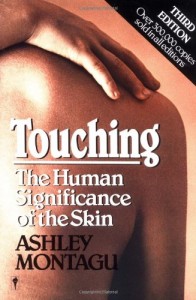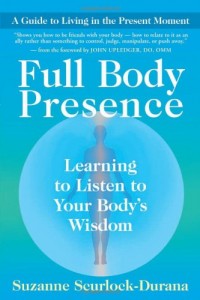Touch As Nutrition
Touch could properly be regarded as a form of nutrition.
We mistakenly think that touch occurs on the periphery of our self, a skin thing. But truthfully each surface stimulus travels far into the most hidden interior landscapes of our self, traversing long nerve cells right through the buried spinal core to enter and gather in the deep folds of our brain. It’s not by accident that our skin and brain each are generated from a single ectodermic substance, cascading outwards and inwards as we grow in the womb, because right at the very root and origin of us, we are built to connect the inner and outer worlds.
 The necessity of nurturing touch is very clear when we are at our youngest. Without it, young children have the potential to wither and even die, though they are provided with food and medicine.
The necessity of nurturing touch is very clear when we are at our youngest. Without it, young children have the potential to wither and even die, though they are provided with food and medicine.
Slightly older children typically find ways to build a huge, varied diet of touch into their lives. From, at the rough end of the spectrum, tumbling unexpectedly onto their parents’ shoulders, rolling on the floor with siblings, wrestling with friends, to cuddling, sitting on knees, being carried, stroked and gently soothed at the other. Children actively shape their sense of self, not just mentally, but with their hands, elbows and knees, their bellies and mouths, inside the frequency, textures and intensities of this constant, rich field of contact.
(This is why non-nurturing, violent or invasive touch can be so devastating for a child, because it does harm right in the deep heartland of a child’s emerging identity.)
As we grow up we exchange this banquet of physical contact, all that rough and tumbling rolling around for…. well, often for very little.
For most of us, growing up coincides with a reduction in the range and quality of our tactile life. Our diet of nurturing physical contact thins out and narrows down. Ask yourself how your tactile day went today?
In fact, if we do assign a nutritional value to touch, it is clear that many, perhaps most adults, regardless of whether they are alone or in partnership, suffer from significant degrees of starvation in this arena. While some adults participate in contact sports or practices, seek out massage or physical therapies, most do not. While some adults have relationships that offer them a range of healthy touch, including but not confined to sexual, most relationships do not. Instead, we have a state of widespread tactile famine, a malnourishment that is so entrenched as normal we cannot even see that it exists.
 We participate in this under-nourishing of the body in many ways. The abundance of touching we once offered to others, for example, soon becomes rationed out, reserved for appropriate moments with appropriate people. Unlike the sometimes chaotic, improvised and spontaneous interactions of children at play, almost all of these moments, a handshake, a friendly hug, a pat on a colleague’s back, are highly stereotyped too, habitual and fairly unconscious exchanges of brief physical contact. Most of these moments also require a highly muted intensity. Sex therefore, for many adults, whether regular or infrequent, loving or casual, ends up carrying the entire burden of our need for intense nurturing touch. It’s a heavy task it often fails at.
We participate in this under-nourishing of the body in many ways. The abundance of touching we once offered to others, for example, soon becomes rationed out, reserved for appropriate moments with appropriate people. Unlike the sometimes chaotic, improvised and spontaneous interactions of children at play, almost all of these moments, a handshake, a friendly hug, a pat on a colleague’s back, are highly stereotyped too, habitual and fairly unconscious exchanges of brief physical contact. Most of these moments also require a highly muted intensity. Sex therefore, for many adults, whether regular or infrequent, loving or casual, ends up carrying the entire burden of our need for intense nurturing touch. It’s a heavy task it often fails at.
Equally, our ascension into adulthood is often accompanied by the acquisition of goods and services that reduce the tactile shock of the world on our system. Comfortable furniture, convenient transport over smooth highways, and clothes and shoes that protect us from bumps or holes in the land or temperature: all conspire to soothe and dull the senses, especially touch. We are not numb, but we have arranged the world to induce a kind of torpor compared to what we could experience.
Touch cannot be talked about in polite society. No index of well-being seems to have measured it. But sometimes the absence of touch is acknowledged by proxy. Loneliness is one of its stand ins. Loneliness has many dimensions, but the absence of being held, stroked and touched is surely one of its most painful characteristics. The U.K. has a particular crisis here, coming 26th out of 28 European countries in a survey of who has neighbors or friends to turn to. According to the Campaign to End Loneliness, lacking social connections has the equivalent on health as smoking 15 cigarettes a day.
The loneliness which blights the last years of so many elderly people in our culture is based just as much on a physical deprivation as an emotional one. Two fifths of elderly people report that the television is their main company. And we know that loneliness can kill just as assuredly at this end of life as physical isolation killed at the beginning end. Solitary elderly people are almost 50 percent more likely to die early than those who have family, friends or community.
We could talk about poverty of touch just as validly as poverty of wealth, and although this is not confined to this area, frequently the two go together. Walk around a poor estate, and along with cramped and frayed housing, you will see many people, perhaps adults more than children, for whom reliable and consistent nurturing touch is but a memory, a yearning, perhaps an inflamed wounding, rather than a daily sustaining occurrence.
I am sure that for some people turning to aggression and physical violence is an ill judged act of substitution, motivated by a desperate need for the deep, meaningful contact that is missing. The shoving, grappling and hitting provide a perverse reminder, a tragic hint of the intense physical significance we all depend on for our sense of mattering in the world.
Individually and collectively, we need to recover a world that will nurture us, build a society that will sustain rather than erode us. Social and economic policies that prioritize real human need are priorities. But part of this task will also be to regenerate the possibilities of healthy nurturing touch in our lives and in our culture.
There are many reasons to think this is possible, because a good half of the work here is to simply pay attention to our already existing tactile experience, and to edge it forward just a little. As we pick up the mug of tea, we notice the weight and shape, the particular balance between strength and delicacy the porcelain has achieved, the contrast between the experience of the fingers and the experience of the lips. We can ignore the signs, step off the path and walk on the bumpy grass, among the trees, trail a hand across its trunk. We can once more hold our partner’s hand with some portion of the attention we brought to the miraculous first time we felt those fingers wrap around ours.
Key in the front door at the end of a stressful day, we can appreciate the ability of children to restore us. Because they plunge us back into a universe of sensation and tactile experience. They climb on us, tumble over our head or shoulder, jump on our backs, elbow us and knee us and rough us gloriously up. They break through the crust we have carefully built around our nervous system. They speak to us at a level we have forgotten about, but thirst for: the elemental dimension of physical contact.



Absolutely fascinating! I’m a huge advocate of touch as early as possible in life. I’ve seen the amazing effects- improved weight gain, temperature regulation, better respiration, lessened stress, etc.- of kangaroo care (skin-to-skin contact) in NICUs and at home. It’s incredible to see the positive impact of touch!